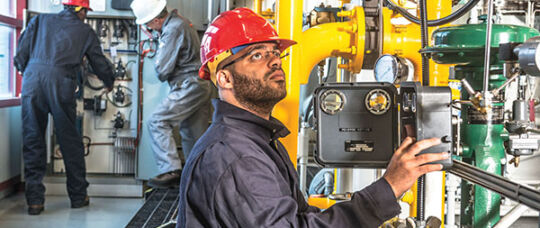What Does Roar Solutions Mean?
What Does Roar Solutions Mean?
Blog Article
Rumored Buzz on Roar Solutions
Table of ContentsRoar Solutions Fundamentals ExplainedNot known Facts About Roar SolutionsThe smart Trick of Roar Solutions That Nobody is Discussing
In such an environment a fire or explosion is possible when 3 standard problems are fulfilled. This is typically referred to as the "dangerous area" or "combustion" triangle. In order to safeguard installations from a potential surge an approach of evaluating and categorizing a potentially unsafe area is needed. The purpose of this is to guarantee the appropriate selection and installation of devices to ultimately protect against a surge and to make sure security of life.
(https://www.indiegogo.com/individuals/38463782)
No equipment should be set up where the surface temperature of the devices is more than the ignition temperature level of the provided threat. Below are some usual dirt unsafe and their minimum ignition temperature. Coal Dirt 380C 225C Polythene 420C (thaws) Methyl Cellulose 420C 320C Starch 460C 435C Flour 490C 340C Sugar 490C 460C Grain Dirt 510C 300C Phenolic Resin 530C > 450C Aluminium 590C > 450C PVC 700C > 450C Soot 810C 570C The chance of the threat being present in a concentration high sufficient to trigger an ignition will certainly differ from area to area.
In order to classify this risk a setup is divided into areas of risk relying on the quantity of time the harmful is present. These areas are referred to as Areas. For gases and vapours and dirts and fibres there are three areas. Area 0 Zone 20 A dangerous atmosphere is highly most likely to be existing and may be present for lengthy periods of time (> 1000 hours each year) and even continuously Area 1 Zone 21 A harmful environment is possible yet not likely to be present for extended periods of time (> 10 450 C [842 F] A classification of T6 means the minimal ignition temperature level is > 85 C [185 F] Harmful location electrical equipment possibly developed for usage in greater ambient temperatures. This would certainly suggested on the rating plate e.g. EExe II C T3 Ta + 60C( This suggests at 60C ambient T3 will not be surpassed) T1 T1, T2, T3, T4, T5, T6 T2 T2, T3, T4, T5, T6 T3 T3, T4, T5, T6 T4 T4, T5, T6 T5 T5, T6 T6 T6 A T Course ranking of T1 indicates the maximum surface area temperature generated by the tool at 40 C is 450 C. Assuming the connected T Class and Temperature level rating for the devices are appropriate for the location, you can constantly utilize an instrument with a much more stringent Department rating than needed for the area. There isn't a clear response to this concern sadly. It actually does depend on the kind of equipment and what fixings require to be brought out. Tools with particular test treatments that can't be carried out in the field in order to achieve/maintain 3rd party rating. Should return to the manufacturing facility if it is prior to the tools's service. Field Fixing By Authorised Worker: Difficult testing may not be called for however certain procedures might require to be adhered to in order for the devices to keep its 3rd party rating. Authorized employees have to be used to perform the work appropriately Repair work need to be a like for like substitute. New part must be thought about as a straight replacement needing no special testing of the equipment after the repair work is total. Each tool with a hazardous score should be evaluated independently. These are described at a high level listed below, however, for even more detailed information, please refer directly to the guidelines.
The Roar Solutions Ideas
The devices register is an extensive database of tools records that consists of a minimum set of areas to determine each thing's location, technological specifications, Ex-spouse category, age, and environmental information. This details is critical for tracking and taking care of the equipment properly within harmful areas. On the other hand, for routine or RBI sampling inspections, the quality will certainly be a combination of In-depth and Close inspections. The ratio of Thorough to Close examinations will be established by the Devices Danger, which is analyzed based on ignition threat (the possibility of a resource of ignition versus the possibility of a combustible atmosphere )and the harmful location classification
( Area 0, 1, or 2). This variant will certainly also influence the resourcing demands for work prep work. As soon as Lots are specified, you can develop sampling plans based upon the sample size of each Lot, which refers to the number of random devices products to be evaluated. To determine the required sample size, two facets require to be evaluated: the size of the Great deal and the classification of examination, which indicates the level of effort that ought to be applied( minimized, typical, or boosted )to the inspection of the Great deal. By integrating the classification of examination with the Lot size, you can after that establish the ideal denial standards for an example, meaning the allowed number of malfunctioning products discovered within that sample. For even more information on this process, please refer to the Energy Institute Standards. The IEC 60079 standard advises that the optimum period between evaluations must not go beyond 3 years. EEHA inspections will certainly additionally be conducted beyond RBI campaigns as part of set up maintenance and equipment overhauls or repairs. These inspections can be attributed towards the RBI example sizes within the influenced Great deals. EEHA evaluations are conducted to determine mistakes in electrical equipment. A weighted racking up system is crucial, as a solitary piece of equipment might have multiple mistakes, each with differing degrees of ignition risk. If the mixed score of both examinations is much less than twice the mistake score, the Whole lot is considered appropriate. If the Lot is still considered unacceptable, it should undertake a full evaluation or justification, which might set off more stringent evaluation methods. Accepted Great deal: The reasons for any mistakes are recognized. If a common failing setting is discovered, added devices may require inspection and repair service. Mistakes are classified by intensity( Safety and security, Stability, House cleaning ), making certain that urgent concerns are evaluated and resolved without delay to alleviate any impact on security or operations. The EEHA data source should track and tape the lifecycle of mistakes along with the restorative actions taken. Carrying out a durable Risk-Based Examination( RBI )approach is essential for making sure conformity and safety in managing Electrical Equipment in Hazardous Locations( EEHA) (eeha certificate). Automated Fault Scoring and Lifecycle Management: Effortlessly manage faults and track their lifecycle to boost examination precision. The intro of this assistance for risk-based inspection further strengthens Inspectivity's setting as a best-in-class option for regulative conformity, along with for any kind of asset-centric assessment usage instance. If you want finding out extra, we welcome you to ask for a presentation and uncover how our option can change your EEHA monitoring procedures.
Everything about Roar Solutions

In regards to explosive threat, a dangerous area is an environment in which an eruptive environment is existing (or may be expected to be existing) in quantities that call for special preventative measures for the construction, installment and use tools. eeha courses. In this post we explore the this article challenges dealt with in the workplace, the danger control steps, and the needed competencies to function safely
It is an effect of modern life that we produce, save or deal with a series of gases or liquids that are regarded flammable, and a range of dusts that are regarded combustible. These materials can, in certain conditions, create eruptive environments and these can have significant and heartbreaking consequences. A lot of us are acquainted with the fire triangular remove any kind of one of the 3 components and the fire can not occur, yet what does this mean in the context of dangerous areas? When damaging this down into its easiest terms it is basically: a combination of a certain amount of launch or leakage of a specific compound or material, blending with ambient oxygen, and the visibility of a source of ignition.
In the majority of instances, we can do little about the degrees of oxygen airborne, yet we can have substantial influence on sources of ignition, for instance electrical devices. Unsafe locations are recorded on the unsafe area classification drawing and are recognized on-site by the triangular "EX-SPOUSE" sign. Below, amongst other key info, areas are divided right into three types depending on the risk, the possibility and duration that an eruptive ambience will exist; Area 0 or 20 is regarded one of the most harmful and Zone 2 or 22 is deemed the least.
Report this page